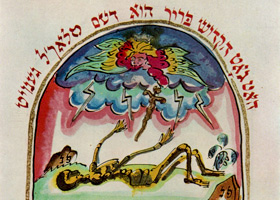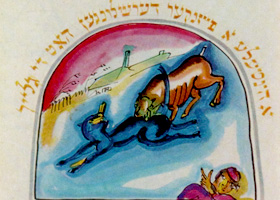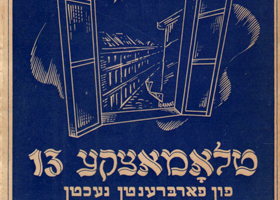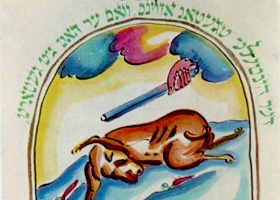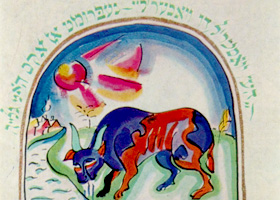| Yiddish Language Instruction |
|
Language Yiddish instruction is offered at three levels (beginners, intermediate and advanced) throughout the academic year. For detailed information about these classes and to register, please contact the Division of Foreign Languages at Tel Aviv University, Tel: 6409465/6409681, or contact This e-mail address is being protected from spambots. You need JavaScript enabled to view it Beginners: Mr. Daniel Birnbaum, Monday, 12:00-16:00, Webb 215 Intermediate: Mr. Daniel Birnbaum, Wednesday, 12:00-16:00, Webb 215 Advanced: The Andrew Stevens Course in Yiddish Literature 2015-16 Dr. Oren Roman, Wednesday 12:00 - 14:00, Webb 401
Literature B.A. Courses 2015/16 Dr. Aviv Livnat, Fall Semester, Wednesday, 10:00-12:00, Gilman 280 Falling Stars: Yiddish Cinema between East and West (with the Department of General BA-Studies) Yiddish film was part of the modern gust of wind which threatened to destabilize Jewish society during the first decades of the twentieth century and one can find in it reflections of social, psychological and spiritual turmoil. Dr. Aviv Livnat, Spring Semester, Wednesday, 14:00-16:00, Gilman 307 Yiddish and Avant-Garde in Inter-War Eastern Europe (with the Department of General BA-Studies) The course will deal with developments of Avant-Garde trends among the yiddish speaking Jewish population in inter-war Eastern Europe. The focus will be mainly on Yiddish Avant-Garde as expressed in Political tendencies and artistic currents as Expressionism, Futurism, Constructivism, Dadaism, Anarchism and diverse expressions of political and artistic Avant-Garde. Dr. Gali Drucker Bar-Am, Fall Semester, Thursday, 14:00-16:00, Gilman 278 Literature and the Challenge of Modernity: The Case of Yiddish This course is an introduction to modern Yiddish literature. We shall read—in Hebrew—from the writings of Reb Nahman of Bratslav, Mendele Moykher-Sforim, Sholem Aleichem, I.L. Peretz, Isaac Bashevis Singer, Avrom Sutzkever, and others. Yiddish was the language of the overwhelming majority of the Jewish people for centuries. Yiddish culture developed under exceptional historical and social circumstances and Yiddish literature expresses these circumstances. Students will be introduced to the challenges of Jewish life in Eastern Europe, America, and Israel. An answer to these challenges often came in the form of fascinating avant-garde and experimental literary works. In particular, we shall examine the ways in which Yiddish literature dealt with the rise of modernity, nationalism, secularization, urbanization, mass migration, the dissolution of the traditional community, and Yiddish’s complex relationship with Hebrew and the establishment of Israel.
M.A. Seminars 2015/16 Dr. Claudia Rosenzweig, Spring Semester, Thursday 16:00-18:00, Gilman 362א Tales from Early Yiddish Literature: from the mayse to the modern short story The mayse has been a prominent genre throughout the history of Yiddish literature, from the brief story found in a 14th-century manuscript, through compositions influenced by the medieval exemplum and the novella of the Italian Renaissance, to the Hassidic tale and later rewritings of the genre in Modern Yiddish literature. Dr. Zehavit Stern, Spring Semester, Wednesday, 14:00-16:00, Gilman 362א The Re-Imagination of Folklore in Modern Eastern European Jewish Culture In this seminar we will examine the re-discovery and invention of Eastern European Jewish folklore in modern Jewish culture. We'll ask questions such as: Does folklore have any aesthetic value? What is the relation between folklore and high culture? What ideologies motivated the re-imagination of folklore? How can folklore be translated into a modern, or modernist, work of art? Through a variety of sources, including prose, poetry, drama and political essays in Hebrew and Yiddish, visual works and films, the course traces the dramatic religious and political changes experienced and led by Eastern European Jewish artists, who strived for an aesthetic transformation of folklore, and through it aspired to bring together tradition and revolution, aesthetic innovation and links to a--real or imagined--Jewish heritage.
Previous Years
B.A. Courses 2014/15
Dr. Aviv Livnat, Fall Semester, Wednesday, 10:00-12:00, Gilman 326
Falling Stars: Yiddish Cinema between East and West (with the Department of General BA-Studies) Yiddish film was part of the modern gust of wind which threatened to destabilize Jewish society during the first decades of the twentieth century and one can find in it reflections of social, psychological and spiritual turmoil.
Dr. Gali Drucker Bar-Am, Spring Semester, Thursday, 10:00-12:00, Gilman 307 The Andrew Stevens Course in Yiddish Literature: Modern Yiddish Literature and the ‘Being in Nature’ Experience In this course we will examine the significance of "being in nature" in the canonical works of modern Yiddish literature. We will focus on the way in which modernity (as a worldview and historical period) has reshaped the Jewish experience of belonging in various landscapes, be they of "foreign" homelands or of the national homeland (Israel). Judaism, in its post-biblical forms, was shaped, as a religion, culture, and national identity in Diaspora. In ideologies developed by Jews in various lands, their existential posture of dwelling "abroad" (in Exile, awaiting restoration to their point of origin) implied an inherent ambivalence with regard to their home or "native" ground – which was also Galut (Exile). The unsettling consciousness of oneself as being alien to one's embracing environment is thus a root-experience of great import that is part and parcel of the Jewish experience as such. Nowhere is this more obvious than in literary descriptions of encounters with every-day, natural surroundings. It is equally and paradoxically apparent in literary treatments of "longing" for lost surroundings. Our aim is to study key literary representations of this paradox: of feeling “at home” in one’s unrealized longings for a homeland, and an alien in one’s native land. We will be reading from the works of Mendele Moykher Sforim, Yehoash, M. Kulbak, R. Korn, Y.Y. Schwartz, I. Raboi, A. Sutzkever, R. Fishman, and M. Mann.
Dr. Aviv Livnat, Spring Semester, Wednesday, 14:00-16:00, Gilman 306 Yiddish and Avant-Garde in Inter-War Eastern Europe (with the Department of General BA-Studies) The course will deal with developments of Avant-Garde trends among the yiddish speaking Jewish population in inter-war Eastern Europe. The focus will be mainly on Yiddish Avant-Garde as expressed in Political tendencies and artistic currents as Expressionism, Futurism, Constructivism, Dadaism, Anarchism and diverse expressions of political and artistic Avant-Garde.
M.A. Seminars 2014/15 Professor Hana Wirth-Nesher, Spring Semester, Thursday, 14:00-16:00, Gilman 261
Jewish Writing and Theories of Literature (Crosslisted in the Department for English and American Studies and the Department of Literature) This seminar will examine theories of literature that can be used as a framework for discussing Yiddish and Jewish writing, either by addressing this literature directly or by posing questions that pertain to the production, reception, and poetics of Yiddish and Jewish writing. Modern Yiddish literature will be studied in relation to the concept of fusion language, minority discourse, bilingual aesthetics, intertextuality, literature and nation, ethnicity, translation theory, modernism, and metalanguage. Readings will be drawn from the works of Bal Makhshoves, Shmuel Niger, Benjamin Harshav, Chaim Rabin, Dan Miron, Deleuze and Guattari, Emily Apter, David Damrosch, Naomi Seidman, Doris Sommer, Chana Kronfeld, Ruth Wisse, Cynthia Ozick, Walter Benjamin, and David Roskies. Literary readings will be drawn from Sholem Aleichem, Isaac Bashevis Singer, Lamed Shapiro, Isaac Raboy, Franz Kafka, Abraham Cahan, Henry Roth, Saul Bellow, Isaac Rosenfeld, and Cynthia Ozick, among others.
Dr. Claudia Rosenzweig, Spring Semester, Thursday 16:00-18:00, Gilman 307 Yiddish Literature in the Early Modern Period, in the Lands of the German and Romance Languages The course is designed to serve as an introduction to Yiddish literature in the Early Modern period, notably in Germany, Italy, Holland and Central Europe. We will deal with key topics such as the history of research in the field, and an historical outline of the Yiddish language and bilingualism in Ashkenaz, and will explore the principal genres of this literature, especially translations of the Bible, chivalric texts, collections of stories (mayses) such as the Küh-bukh and the Mayse-bukh, poetry (lampoons and 'historical songs'), and the Memoirs of Glikl of Hameln. During the course we will underline the development and continuity of the main genres and of specific works in the history of Yiddish literature, and highlight their relevance for Modern Yiddish literary writing. The course will include bibliographical instruction and readings of selected texts from this rich tradition.
B.A. Courses 2013/2014 Mr. Aviv Livnat, Fall Semester, Wednesday, 10:00-12:00, Gilman 456 Falling Stars: Yiddish Cinema between East and West (with the Department of General BA-Studies) Yiddish film was part of the modern gust of wind which threatened to destabilize Jewish society during the first decades of the twentieth century and one can find in it reflections of social, psychological and spiritual turmoil.
Ms. Gali Druker Bar-Am, Spring Semester Home, immigration, and refuge in modern Yiddish literature Modern Yiddish literature was born in Eastern Europe during the second half of the 19th century and reached its peak between the two world wars. This period witnessed a social and cultural upheaval, beginning in the home (both as a physical space and as an emotional habitat) and the family. Through modern Yiddish literature one can track this process of disintegration and its far-reaching B.A. Courses 2012/2103 Mr. Aviv Livnat, Fall Semester, Wednesday, 10:00-12:00, Gilman 307 Falling Stars: Yiddish Cinema between East and West (with the Department of General BA-Studies) Yiddish film was part of the modern gust of wind which threatened to destabilize Jewish society during the first decades of the twentieth century and one can find in it reflections of social, psychological and spiritual turmoil. This cinematic treasure allows for a unique look into three dynamic and most dramatic decades in the Jewish sphere- days full of promise and new opportunities, while at the same time echoing a growing distress and anticipating imminent tragedy. Many films deal with the fracture of the Jewish traditional community and the Jewish family during an age of massive immigration, urbanization, and modernization. Some deal with the tension between Jewish and gentile professions such as Chazan and opera singer; others deal with politics, education and Jewish identity, gender issues, religion and secularization, dibbuks and mystics. After the war, Yiddish film lost its audience, its creative forces. The Yiddish cinema stars who did survive, the falling stars, expressed the path of the Yiddish cinema which was bright and fast both in its ascent and decline. During the course we will examine the artistic cooperation within important cinema productions in the Polish, Russian and American scenes and the reception of those films. The course will also examine comparative aspects of Yiddish and general cinema with its avant-garde and mainstream tendencies as well as its contribution to the Hollywood project. Mr. Aviv Livant, Spring Semester, Wednesday, 14:00-16:00. Gilman 304 Yiddish and Avant-Garde in Inter-War Eastern Europe (with the Department of General BA-Studies) The course will deal with developments of Avant-Garde trends among the yiddish speaking Jewish population in inter-war Eastern Europe. The focus will be mainly on Yiddish Avant-Garde as expressed in Political tendencies and artistic currents as Expressionism, Futurism, Constructivism, Dadaism, Anarchism and diverse expressions of political and artistic Avant-Garde. The course will deal with varied expressions of Avant-Garde in Yiddish Literature and poetry, theatre, cinema, and the Arts. Visual presentations, music, films and special archival materials will accompany the course. Gali Drucker Bar-Am, Spring Semester, Thursday, 10:00-12:00, Gilman 279 Literature and the Challenge of Modernity: The Case of Yiddish. This course is an introduction to the canons of modern Yiddish literature. We shall read—in Hebrew—from the writings of Reb Nahman of Bratslav, Mendele Moykher-Sforim, Sholem Aleichem, I.L. Peretz, Isaac Bashevis Singer, Avrom Sutzkever, and others.
Yiddish was the language of the overwhelming majority of the Jewish people for centuries. Yiddish culture developed under exceptional historical and social circumstances and Yiddish literature expresses these circumstances. Students will be introduced to the challenges of Jewish life in Eastern Europe, America, and Israel. An answer to these challenges often came in the form of fascinating avant-garde and experimental literary works. In particular, we shall examine the ways in which Yiddish literature dealt with the rise of modernity, nationalism, secularization, urbanization, mass migration, the dissolution of the
M.A. Seminars - 2013/2014
Dr. Claudia Rosenzweig, Spring Semester
Tales from Early Yiddish Literature: from the mayse to the modern short story
The mayse has been a prominent genre throughout the history of Yiddish literature, from the brief story found in a 14th-century manuscript, through compositions influenced by the medieval exemplum and the novella of the Italian Renaissance, to the Hassidic tale and later rewritings of the genre in Modern Yiddish literature.
M.A. Seminars 2012/2013
Professor Hana Wirth-Nesher, Spring Semester, Thursday, 14:00-16:00, Webb 105
Jewish Writing and Theories of Literature (Crosslisted in the Department for English and American Studies and the Department of Literature) This seminar will examine theories of literature that can be used as a framework for discussing Yiddish and Jewish writing, either by addressing this literature directly or by posing questions that pertain to the production, reception, and poetics of Yiddish and Jewish writing. Modern Yiddish literature will be studied in relation to the concept of fusion language, minority discourse, bilingual aesthetics, intertextuality, literature and nation, ethnicity, translation theory, modernism, and metalanguage. Readings will be drawn from the works of Bal Makhshoves, Shmuel Niger, Benjamin Harshav, Chaim Rabin, Dan Miron, Deleuze and Guattari, Emily Apter, David Damrosch, Naomi Seidman, Doris Sommer, Chana Kronfeld, Ruth Wisse, Cynthia Ozick, Walter Benjamin, and David Roskies. Literary readings will be drawn from Sholem Aleichem, Isaac Bashevis Singer, Lamed Shapiro, Isaac Raboy, Franz Kafka, Abraham Cahan, Henry Roth, Saul Bellow, Isaac Rosenfeld, and Cynthia Ozick, among others. Dr. Claudia Rosenzweig, Spring Semester, Thursday 16:00-18:00, Gilman 317 Yiddish Literature in the Early Modern Period, in the Lands of the German and Romance Languages The course is designed to serve as an introduction to Yiddish literature in the Early Modern period, notably in Germany, Italy, Holland and Central Europe. We will deal with key topics such as the history of research in the field, and an historical outline of the Yiddish language and bilingualism in Ashkenaz, and will explore the principal genres of this literature, especially translations of the Bible, chivalric texts, collections of stories (mayses) such as the Küh-bukh and the Mayse-bukh, poetry (lampoons and 'historical songs'), and the Memoirs of Glikl of Hameln. During the course we will underline the development and continuity of the main genres and of specific works in the history of Yiddish literature, and highlight their relevance for Modern Yiddish literary writing. The course will include bibliographical instruction and readings of selected texts from this rich tradition.
2011 - 2012 Mr. Roy Greenwald, Spring Semester, Monday, 16:00- 18:00, Gilman 306 A World Downhill: Modernism between Revolution and Destruction Yiddish literature written between the two world wars was a site for bold experiments reflecting the revolutionary ideologies and modernist impulses that dominated the Yiddish artistic scene on both sides of the Atlantic. This course will focus on major works in both prose and poetry dating from this turbulent period and our readings will try to trace the violent and productive encounter between Yiddish culture and modernist movements in Europe and America. Reading material will be in Hebrew translation and no knowledge of Yiddish is required. 2010-2011 Mr. Roy Greenwald, Spring Semester, Sunday 14:00-16:00, Gilman 280 Writing in a Minority Language (with the Department of Literature) In this course, we will explore the meaning of writing in a minority language as reflected in four classic novels in Yiddish literature by Mendele Moyker Sforim, Sholem Aleykhem, Yankev Glatshteyn and Isroel Rabon. We will try to understand the characteristic features of a literature that is written in a minority language--a literature, that is not written within a national territory but is rather nomadic across both space and time. In addition to reading the literary works themselves, we will also look at several theoretical approaches to the matter. No knowledge of Yiddish is required; the novels can be read in Hebrew translation. 2009-10 Mr. Matan Hermoni, Fall Semester, Monday 14:00-16:00, Webb 102 Jewish Writings in America (crosslisted in the Departments of General BA-Studies, of Literature and of English and American Studies) The course deals with Jewish writings in America at the turn of the 20th century, and the poetic peaks reached especially by Yiddish literature, faithfully depicting immigrant life in the New World. During the course we will examine the evolution of American Jewish Literature, from the Haskala tradition, through the popular "Pulp" (Shund) literature and into the mature Modernist works of the 1920's and 1930's, works that include some of the highlights not only of Jewish literature but of all Modernist writing. The course is historically oriented and will examine the ways in which history was expressed poetically. Special consideration will be given to the contrast between the Old continent and the New World; the major tension behind the Jewish literary works of the era. The works that will be read include: Sholem Aleichem: Mottle, Paisy the Cantor's Son L. Shapiro – "Doc" Y. Glatshteyn - The Yash Novels Finally we will read a selection of Yiddish poems by poets such as Moishe-Leib Halpern, Many Leib and A.G. Leyeles. Texts can be read in either English or Hebrew translation, the language of instruction is Hebrew. Papers and assignments for students in the English department will be in English. Reading Material: Matan Hermoni - Yiddish in America Mr. Aviv Livnat, Fall Semester, Wednesday 12:00-14:00, Gilman 277 Yiddish and Avant-Garde in Interwar Eastern Europe (General BA-Studies) The course deals with developments of Avant-Garde trends among the Yiddish speaking Jewish population in interwar Eastern Europe. It will deal with varied expressions of Avant-Garde in Yiddish literature and poetry, theatre, cinema, and the arts. We will focus mainly on the Yiddish Avant-Garde as expressed in political tendencies and artistic currents such as Expressionism, Futurism, Constructivism, Dadaism, Anarchism and diverse expressions of the political and artistic Avant-Garde. Visual presentations, music, films and special archival materials will accompany the course. Reading Material can be obtained at the virtual TAU-HighLearn course platform Previous Years 2008-9 Mr. Roy Greenwald, Spring semester, Sunday 16:00-18:00 Portrait of a Catastrophe: Modernist Yiddish Literature (with the Department of Literature) In this course we will discuss the representation of violence in the works of three central Yiddish writers of the 20th century: The writer Lamed Shapiro and the poets Peretz Markish and Uri Zvi Greenberg. By close readings of their works, we will analyze their attitudes toward Jewish tradition, martyrology, and historiography. We will also read theoretical texts by Walter Benjamin as well as prominent manifestos of the Yiddish avant-garde. During the course we will discuss poetic aspects of writings which were, without exception, written in light of the approaching catastrophe. The course does not require knowledge of the Yiddish language, as the texts will be read in the Hebrew translation. Course requirement: term paper. 2007-8 Professor Dan Miron, Department of English and American Studies (cross listed with the Department of Literature) This course examined New York as a Real and Symbolic 'Locus' in Yiddish American Literature. It addressed the main aspects of the Jewish New York experience as reflected in the writings of Yiddish poets and writers of prose fiction, and traced the various levels of significance the "place" assumed in their works. The course had four foci: a) the New York ambience through the eyes of the immigrants (texts for discussion: a selection from Morris Rozenfeld's "Sweat-Shop" poetry; a selection from Moyshe Leyb Halpern's "In New York" [both Hebrew and Yiddish translations are available), and the Yoysef Opatoshu's first New York novella: "In New-Yorker Ghetto." It also discussed David Ignatov's short novel :"In Kessl Grub," a unique attempt to refract the Immigrants' experience through the prism of Symbolist prose. b) problems of acculturation. The main text was Sholem Asch's "East River," in many ways the author's best creation as well as the most intriguing New York "epic", where a social history of the Jewish garment industry in New york, a rivetting family saga and an exploration of the themes of faith, agnosticism, Jewish-Christian interactions and the emergence of a particular kind of an American-New Yorkish Jewish sainthood (as distinguised from the European-Hasidic brand) are dexterously intertwined. c) New York of the Inzikhistn: a small anthology of New York poems by A.G.Leyeles, Y. Glatshteyn, J.L.Teller and B. Alkvit were discussed as well as excerpts from Glatshteyn's Yash novels. d) "Hard Boiled" Jewish New York of the Great Depression. Main texts: B. Demblin's "West Side" and Berish Vaynshteyn "Brukhvarg 2006-7 Dan Miron, Department of Literature This coursed discussed works of the Yiddish-American poet Y. Glatshteyn. 2005-6 Dan Miron, Department of Literature Bilingual texts in Jewish literatures This course analyzed texts, prose and poetry, written both in Hebrew and in Yiddish. Most of the texts were written during the period of "Hatkhia" at the end of the 19th and the beginning of the 20th century. Students read texts by Hasidic authors as the Baal Shem Tov and Rabbi Nahman, as well as Maskilic parodies on these texts by Yosef Perl. In addition they read works by M. I. Berdichevsky, S. I. Abramovitch, Y.L. Peretz, H.N. Bialik, Yaakov Steinberg and Y.D. Berkovitch. |




